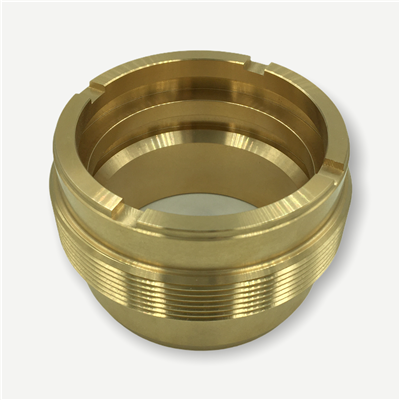By Josh Cosford, Contributing Editor
Bearings are mechanical components designed to bear the load from a complimentary part, such as a shaft. Any shaft in fluid power subjected to loads perpendicular to the axis of movement requires a bearing. In most cylinder examples, one-piece bushings are best suited to support loads, offering exceptional surface area for superior alignment.

Hydraulic cylinder bearing with seal grooves
Image courtesy of CRC Distribution
In reality, a cylinder has two bearings — one on the piston rod and the other at the piston. The piston rod bearing most commonly adopts oil-impregnated bronze to support the rod for side load and misalignment. Oil-impregnated bronze is a powered metal that releases tiny oil packets as it wears, ensuring the rod never galls against the bushing.
Although a long-wearing component, bushings require eventual replacement, so cylinder construction should offer a straightforward method to extract and replace the bearing. Some cylinder manufacturers use a thread-in gland, which allows disassembly while the cylinder remains mounted, so long as the rod end is free from attachment. Other manufacturers employ a slide-in gland held fast by a retainer, which may require tie-rod removal in some cases. A rod gland is just a bearing assembly that includes one or more seal grooves or drains.
For any cylinder bearing, its surface area offers the key to its effectiveness at supporting loads, which may come as either a longer bushing or one of larger diameter. Often a longer bushing cannot fit inside the head of standard cylinders, so that a custom option may be necessary. For example, an oversized rod provides superior column strength and better support from the larger diameter bearing.
Some gland assemblies may use replaceable wear strips on the ID, making replacing the “bearing” quick and inexpensive. However, pound for pound, bronze costs more than any other raw material in a cylinder, so the cost savings for such a solution may be extensive. Inexpensive press-in bushings reduce the investment cost of a gland assembly, but assembly requires both a small press and precise reaming tool, making this option less suitable for quick repairs.
Although pistons are rarely referred to as bearings, they aid in a cylinder’s alignment and load support nearly as much as the bushing. In addition, the distance between the rod bearing and the piston adds to the overall strength of the cylinder assembly, which is why stop tubes are used in long stroke cylinders to improve column strength.
Like with bearings, both the diameter and length of the piston help improve strength, although often the diameter is fixed for any given application. The piston wear strip is a sacrificial component that supports the piston against the tube ID. Although some cylinders have used straight cast iron against the cylinder barrel, a wear strip is a superior option that improves reliability and repairability.
Wear rings, as they’re sometimes called, come manufactured from various materials to support any application. Nylon, glass-filled PTFE, or even bronze- or lead-impregnated material makes an easily replaceable and reliable option for any fluid, temperature or load requirement. If your application may require special protection from misalignment or sideload, be sure to approach your solution wholistically by selecting both bearing and piston assemblies that combine for the best approach.
Filed Under: Cylinders & Actuators, Engineering Basics, Technologies